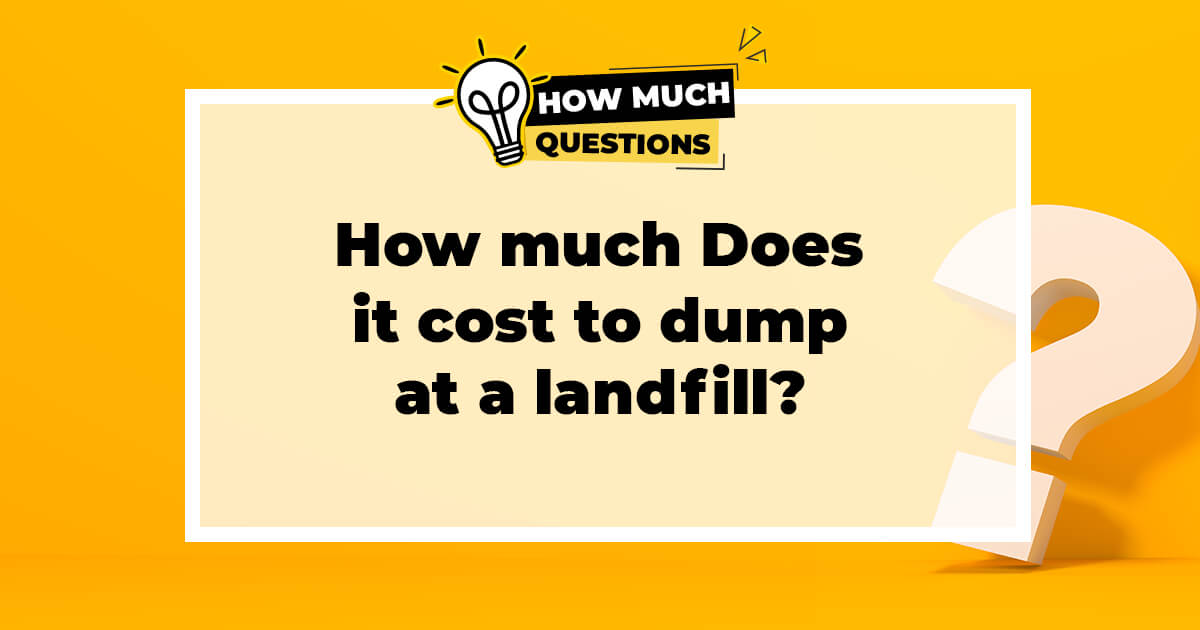How much does it cost to dump at a landfill?
Discover the factors that affect landfill dumping costs and learn how to save money while making responsible choices. Find out how much it really costs to dump at a landfill.

Introduction:
Dumping waste at a landfill might seem straightforward, but the expenses can vary widely based on several key factors. In this article, we will delve into the intricacies of landfill costs, ensuring you have all the information you need to make informed decisions about waste disposal.
How much does it cost to dump at a landfill?
The cost to dump at a landfill varies based on the volume of waste and the location. For instance, Riverbend charges between $19.75 for 1 cubic yard to $62.25 for 5 cubic yards. On average, the U.S. municipal solid waste landfill tipping fee was $53.04 per ton in 2021. In Jackson County, KS, the cost ranges from $11.00 per car load to $21.00 and up for regular pickups.
Factors Influencing Cost:
1. Location and Accessibility:
- The proximity of the landfill to your location.
- Ease of access to the landfill.
2. Type and Quantity of Waste:
- The type of waste being disposed of (e.g., household, construction, hazardous).
- The volume or weight of waste.
3. Landfill Fees and Regulations:
- Landfill fees and tipping charges.
- Environmental regulations and taxes.
4. Transportation Costs:
- Costs associated with transporting waste to the landfill.
5. Time of Disposal:
- Seasonal price fluctuations.
6. Recycling and Composting:
- Opportunities to reduce disposal costs through recycling and composting.
Pre-Purchase Considerations:
1. Waste Classification:
- Understand the nature of your waste.
- Categorize it correctly to avoid penalties.
2. Sorting and Preparation:
- Sort recyclables and hazardous materials.
- Prepare waste for disposal as per landfill guidelines.
3. Landfill Selection:
- Research nearby landfills.
- Compare prices, regulations, and services.
4. Waste Reduction:
- Explore waste reduction strategies.
- Minimize waste generation.
Cost-Saving Tips:
1. Recycling:
- Prioritize recycling to reduce landfill-bound waste.
2. Composting:
- Compost organic materials to decrease waste volume.
3. Waste Reduction:
- Implement waste reduction practices at home and work.
4. Bulk Disposal:
- Coordinate with neighbors or businesses for bulk disposal.
Guidance for Optimal Choices:
1. Environmental Responsibility:
- Choose eco-friendly disposal methods.
- Support recycling and waste reduction initiatives.
2. Local Regulations:
- Stay informed about local landfill regulations.
- Ensure compliance with disposal rules.
3. Professional Assistance:
- Consider consulting waste management professionals for large-scale disposal.
Conclusion:
In conclusion, the cost of dumping waste at a landfill can vary significantly depending on several factors. By understanding these influences, making informed choices, and adopting responsible waste disposal practices, you can not only save money but also contribute to a more sustainable future.
Remember, this article is for informational purposes only. Seek professional advice for specific disposal needs, and don't hesitate to leave your comments or questions below for further clarification. Together, we can make a positive impact on waste management.
FAQ: Frequently Asked Questions
How much does it cost to dump at a landfill?
The cost to dump at a landfill varies depending on the location, type of waste, and the weight of the items. On average, it can range from $20 to $50 per ton. Some landfills also charge a flat fee for certain items.
What types of waste are accepted at landfills?
Most landfills accept general household waste, construction debris, and yard waste. However, hazardous materials, electronics, and certain recyclables might be prohibited or require special handling.
How is the price determined at a landfill?
The price is typically determined by the weight of the waste. Many landfills use scales to weigh vehicles before and after dumping to calculate the fee. Some might also have flat fees for specific items or types of waste.
Are there alternatives to dumping at a landfill?
Yes, recycling centers, composting facilities, and waste-to-energy plants are some alternatives. It's essential to separate recyclable materials and consider donating usable items before resorting to landfills.
Why are landfill fees important?
Landfill fees cover the costs of operating and maintaining the landfill, environmental monitoring, and post-closure care. They also incentivize waste reduction and recycling.
How can I reduce my landfill dumping costs?
By recycling, composting, and reducing waste, you can decrease the amount of trash you send to the landfill and, consequently, the fees you incur.
What is the environmental impact of landfills?
Landfills can produce methane, a potent greenhouse gas. They can also contaminate groundwater if not properly managed. Modern landfills are designed with liners and collection systems to minimize these impacts.
How long do landfills last?
The lifespan of a landfill depends on its size and the rate of waste deposition. On average, a landfill can operate for 30 to 50 years. After closure, it requires monitoring for several more decades.
Can I dump electronics at a landfill?
Many landfills prohibit or restrict the dumping of electronics due to the hazardous materials they contain. It's best to check with your local landfill or consider e-waste recycling programs.
What happens to the waste in landfills?
Over time, waste in landfills decomposes, producing landfill gas, primarily methane and carbon dioxide. Some landfills capture this gas for energy production, while others burn it off to reduce its environmental impact.
If you want to know other articles similar to How much does it cost to dump at a landfill? you can visit the category Waste Management and Disposal.
- Introduction:
- How much does it cost to dump at a landfill?
- Factors Influencing Cost:
- Pre-Purchase Considerations:
- Cost-Saving Tips:
- Guidance for Optimal Choices:
- Conclusion:
- FAQ: Frequently Asked Questions
- How much does it cost to dump at a landfill?
- What types of waste are accepted at landfills?
- How is the price determined at a landfill?
- Are there alternatives to dumping at a landfill?
- Why are landfill fees important?
- How can I reduce my landfill dumping costs?
- What is the environmental impact of landfills?
- How long do landfills last?
- Can I dump electronics at a landfill?
- What happens to the waste in landfills?


Leave a Reply